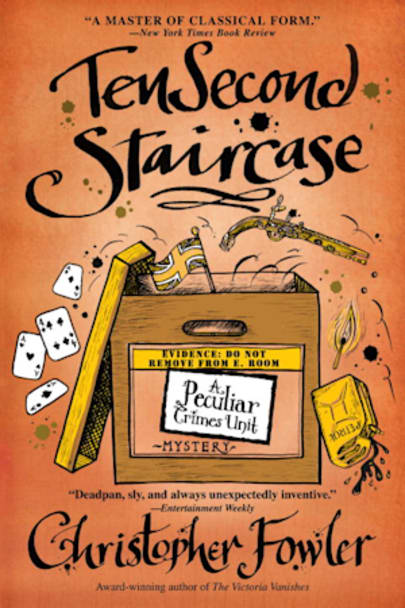It’s a crime tailor-made for the Peculiar Crimes Unit: a controversial artist is murdered and displayed as part of her own outrageous installation. No suspects, no motive, no evidence–it’s business as usual for the Unit’s cantankerous founding partners, Arthur Bryant and John May. But this time they have an eyewitness. According to twelve-year-old Luke Tripp, the killer was a cape-clad highwayman … highwayman atop a black stallion.
As implausible as the boy’s story sounds, Bryant and May take it seriously when “The Highwayman” is spotted again, striking a dramatic pose at the scene of his next outlandish murder. Whatever the killer’s real identity, he seems intent on killing off a string of minor celebrities while becoming one himself.
As the tabloids look to make a quick bundle on “Highwayman Fever,” Bryant and May, along with the newest member of the Unit, May’s agoraphobic granddaughter, April, find themselves sorting out a case involving an unlikely combination of artistic rivalries, sleazy sex affairs, the Knights Templars, and street gang feuds. To do it, they’re going to have to use every orthodox–and unorthodox–means at their disposal, including myth, witchcraft, and the psychogeographic history of the city’s “monsters,” past and present.
And if one unsolvable crime weren’t enough, this case has disturbing links to a decades-old killing spree that nearly destroyed the partnership of Bryant and May once before…and may again. The Peculiar Crimes Unit is one murder away from being closed down for good–and that murder could be their own.
more



All of the Peculiar Crimes Unit books are worth your money! Such a different series and the characters are definitely original. I started buying the hardback versions for my permanent library.
John May and Arthur Bryant are the (aptly designated, since they’re not young men) Senior Detectives for the North London Peculiar Crimes Unit, a unit that “was founded, along with a handful of other specialist departments, soon after the outbreak of World War II, as part of a government initiative to ease the burden on London’s overstretched Metropolitan Police Force, by tackling high-profile cases which had the capacity to compound social problems in urban areas.”
The case confronting them in this particular instance involves a series of murders, all of which are rather bizarre in nature, some of which are seemingly impossible. The victims are people who have achieved celebrity, however dubious, in various fields of endeavor. The perpetrator, according to a schoolboy witness, is a man dressed like a highwayman of old, right down to a cape and a tricorn hat. The boy claims he saw the Highwayman ride into a museum room on a black stallion, lift the first victim, a controversial artist, and dump her into the tank that’s part of her own exhibit. The problems? The Highwayman would have to be extraordinarily tall and strong to have done so, given the height of the tank. He’d also have to be capable of invisibility, since nobody else in the museum saw or heard him or his horse enter or leave.
But the Highwayman, Bryant and May discover, is leaving behind clues. To taunt them? Because he *wants* to be found out?
To compound matters, he begins to make appearances around the city, vanishing before anyone can capture him, and acquires a romantic, rock-star-like aura thanks to the media and the public’s unfavorable perception of his victims. “Highwayman-mania” soon grips London.
During the course of their investigation, Bryant and May notice similarities to an old case they’ve never been able to close: one concerning the so-called Leicester Square Vampire. It has a deeply personal resonance for them because May daughter was one of the Vampire’s victims.
Each sets out to solve the Highwayman case using his own preferred approach. May is the pragmatist and logician, Bryant the radical unhesitant about contacting psychics, self-styled mystics, or anyone else who might be useful. Besides dealing with the case, they have to contend with departmental politics. The Home Office wants to shut down the PCU on the grounds of obsolescence and recent fecklessness.
Bryant and May eventually solve both cases, of course, but not before May’s granddaughter is imperiled as her mother was years before.
TEN SECOND STAIRCASE was a disappointment, but I have only myself to blame for it being so because I had wants and expectations going into it that were unmet. When I first heard about the Bryant and May novels, I had the impression they all involved impossible crimes of some sort, that like the works of Paul Halter they were modern adjuncts to the works of John Dickson Carr, Clayton Rawson, Hake Talbot, and other masters of the miraculous, that they‘d be puzzlers oozing atmosphere. (In fact, there’s a reviewer’s blurb on TEN SECOND STAIRCASE that suggests it’s a locked-room mystery.) What I got was a police procedural about outré crimes complete with social, psychological, and philosophical observations over 464 pages, which is overlong for a mystery.
Apart from its length, the book contains more than a few abstract conversations that are often hard to follow. The characters, despite their quirks, are mostly flat, mere names instead of people who get up off the page and strut their stuff. For all that, Fowler’s style is literate and presumes an intelligent reader. It’s this quality that may eventually prompt me to read another—coupled with the assurance of someone I trust that there’s at least one legitimate locked-room whodunit/howdunit in the series. I can’t resist ’em!
Barry Ergang © 2008